Text

Love banana ketchup? Wish a happy birthday to Maria Ylagan Orosa! As a brilliant chemist she researched ways to cook, jam, can, and produce accessible food for people, including banana ketchup.
“Tia Mary” was born on November 29, 131 years ago today. She earned her bachelor and master of science degrees in pharmaceutical chemistry in 1919. After turning down a chemist position for the US state of Washington, she returned to the Philippines. Rosalinda L. Orosa once wrote that Tia Mary “came home in 1922 to serve her people.”
And serve she did!
She used her chemistry background to concoct various inventions and recipes. She made local jams from guava using tamarind, santol, and calamansi acids, a “palayok oven” which helped Filipinos bake everything from cakes to meats without electricity, and recipes for both banana and mango ketchup. From vinegars to jams to canning, Tia Mary had done it all. One colleague wrote, “Before Del Monte ever thought of making vinegar from pineapple, Miss Orosa had been making it even before World War II.”
But it was in World War II where she would meet her untimely passing. She had refused to evacuate Manila during the war, as she was also part of the resistance movement against the Japanese. She was soon killed by American bombing in Remedios Hospital in Malate, on February 13, 1945.
Source: Helen Orosa del Rosario, 1970. “Recipes of Maria Y. Orosa.”
124 notes
·
View notes
Text
Transformed my initial banana ketchup art into digital form, and later into a simple animation. Learn more about banana ketchup and it’s inventor, Maria Orosa, at Filipino Food Art (free artprint for download too):
https://filipinofood.art/portfolio/banana-ketchup/
1 note
·
View note
Text
Women fighters, in fiction and in reality, have always fascinated me.
I grew up never getting tired of The Mummy Returns (2001) and its action-packed adventures. It features one of my most favorite cinematic moments: the fight scene between Nefertiri and Anck-su-namun, both tasked to be protectors in the kingdom of Egypt some 3,000 years ago. One may think they must be ahead of their time for training women for battle and assigning such tasks to them.

Fight scene from The Mummy Returns (2001)
There are many other scenes in the said film showing both women as their 1930s reincarnation, Evy (Nefertiri) and Meela (Anck-su-namun), fighting with and among men. Not once did Rick, Evy's husband, handed over guns to her to help them battle the enemies and save their son. Their kind of relationship was yet another reason why I have always loved that film.
Seeing The Mummy Returns again for the nth time, I figured these female characters have played a significant part in my upbringing. They showed me women can fight, too, when it was most needed. They didn't have to be the stereotypical damsels in distress waiting to be rescued because they can save themselves while saving others, as well. In retrospect, at such a young age I knew I wanted to be like them. I wasn't very much into the princess thingy, except for the Xena the Warrior Princess kind. In fact, I once dreamed of becoming like the Power Rangers with all their skills and stunts.
Through the years, I have been learning more about Filipinas who left their mark in our history. In an era of a patriarchal society where women were reinforced to be homemakers & deemed as the lesser sex, there were several of them who strayed against the conventions and took part in the never-ending fight for freedom.

Illustrations of Gabriela Silang (by Carlito Rovira) (top) and the first female general Agueda Kahabagan (from SCOUT Magazine) (bottom) during the Philippine Revolution
One of them was notorious for polishing her nails and putting on red lipstick before going to battle, because she believed she also fought for the freedom to be herself as a woman. Another one used to be a movie superstar until the war. She joined the guerrilla movement to avenge for her husband's murder, and in the process she saved an entire village from being killed by the colonizers.
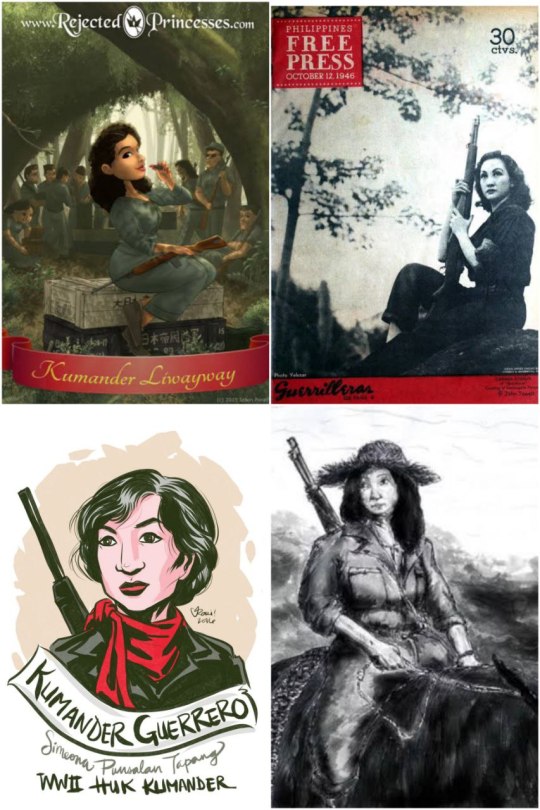
The women of HUKBALAHAP (Hukbong Bayan Laban sa Hapon), clockwise from left:
Remedios Gomez-Paraiso AKA Kumander Liwayway and her red lipstick (art from Rejected Princesses); Carmen Rosales, movie star-turned guerilla fighter (from Flickr); Felipa Culala AKA Kumander Dayang-Dayang (art by Dos Garcia); and Simeona Punsalan-Tapang AKA Kumander Guerrero (art by @RoriComics on Twitter)
But the courage of Filipina women in history has been witnessed not only at home and in the battlefield. There were women who stood up for their right to receive formal education and their right to vote.

Top photo: a painting of The Women of Malolos (art by Rafael del Casal); bottom photo: U.S. First Lady Florence Harding w/ Filipina suffragette delegation, 1922 (From US-Philippines Society)
There were women who saved people's lives by caring for the injured and the sick and feeding the hungry.
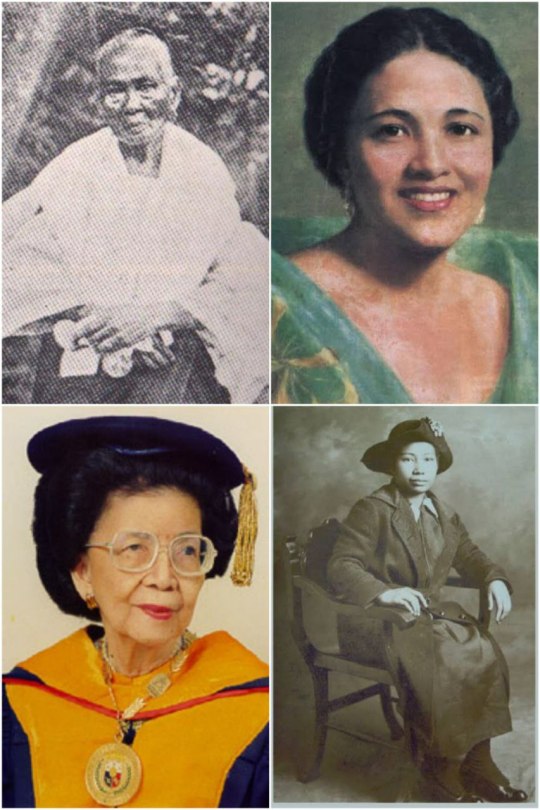
Clockwise from left: Melchora Aquino AKA Tandang Sora (from Wikipedia); Josefa Llanes-Escoda (from Bayaning Filipino on Blogger); Maria Orosa (from Orosa Family); and Dr. Fe del Mundo (from National Academy of Science and Technology)
There were women who continue to fight for justice and for their right to be heard, not just as victims but survivors of a violent, tragic past.
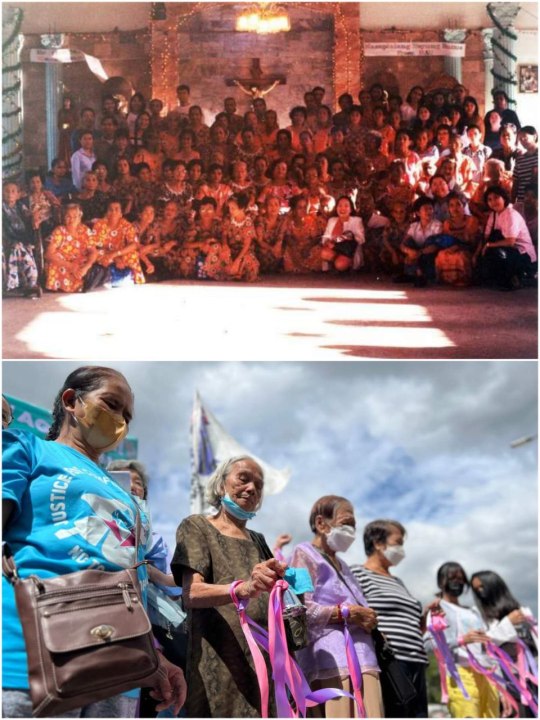
Top photo: the Malaya Lolas of Candaba, Pampanga; bottom photo: the lolas of Lila Pilipina. Both are groups of “comfort women,” survivors of military sexual violence during the Japanese Occupation. (From Facebook)
There were women who prove themselves worthy to be recognized by the world for their talents, abilities, and dedication in their respective fields.

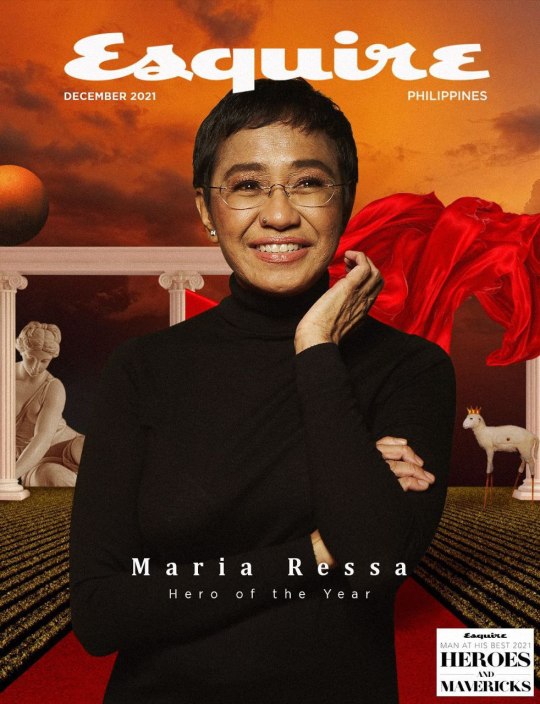
Hidilyn Diaz, the first Filipino Olympic gold medalist; and Maria Ressa, the first Filipino Nobel Laureate (From Esquire Philippines)
There were women leaders who empowered their countrymen towards a better quality of life.

Campaign images of Senator Risa Hontiveros and former Senator Leila de Lima for the 2022 National Elections (From Facebook)
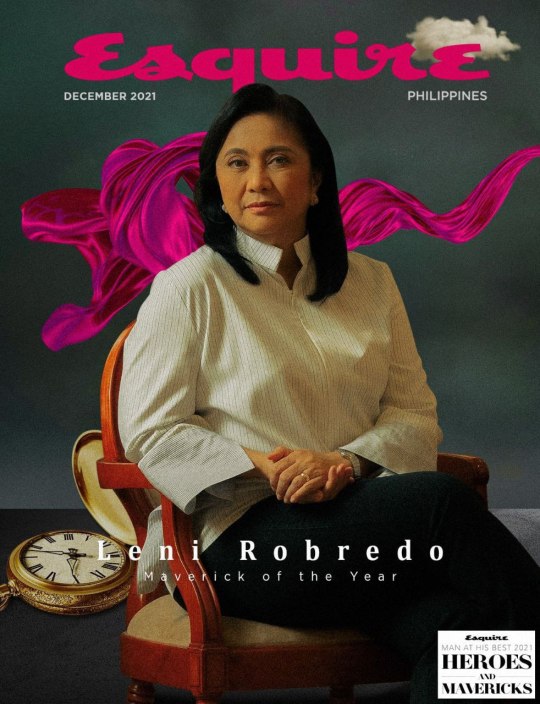
Atty. Leni Robredo, former Vice President of the Philippines (From Esquire Philippines)
And before I forget, I was raised and surrounded by strong women who all the while face their own share of battles in life.
We as women are fighters, and we should never let anyone tell us otherwise.
Meanwhile, I believe I have arrived at a full circle. I may haven't reached my dream of becoming a Power Ranger but who would have thought that as an adult, I would portray a woman fighter myself?
Happy Women's Month!
5 notes
·
View notes
Text
DR. MARIA OROSA // FOOD TECHNOLOGIST
“She was a Filipina food technologist, pharmaceutical chemist, humanitarian and war heroine. She experimented with foods native to the Philippines, and during WWII developed Soyalac (a nutrient rich drink from soybeans) and Darak (rice cookies packed with vitamin B-1, which prevents beriberi disease), which she helped smuggle into Japanese-run internment camps that helped save the lives of thousands of Filipinos, Americans and other nationals. Orosa completed her bachelor’s and master’s degree in pharmaceutical chemistry, as well as an additional degree.”
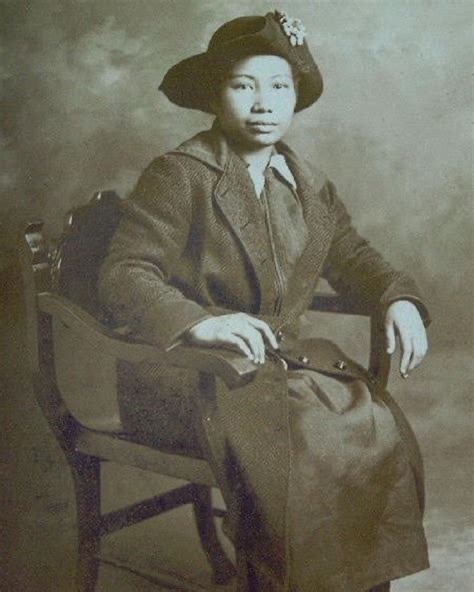
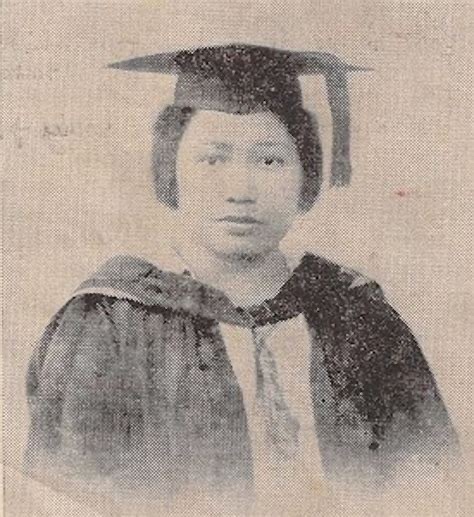
0 notes
Text
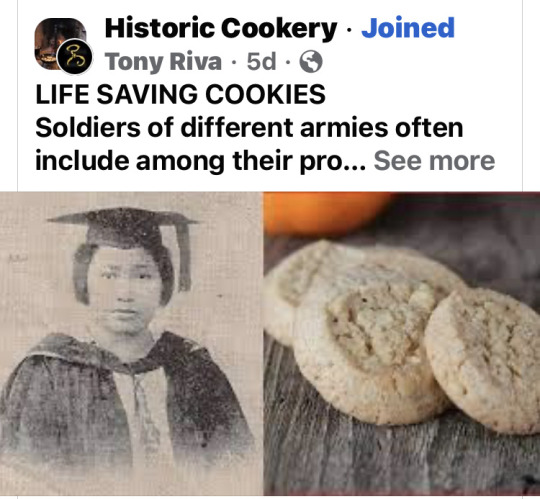
“In what important historical event did Maria Orosa invented the banana ketchup?
Some of Maria's most known contributions to the food world came during World War II. She was beloved within Filipino households for her banana ketchup, but became a war hero for her two other inventions: Soyalac and Darak.”
https://www.nytimes.com/2022/09/29/obituaries/maria-orosa-overlooked.html?smid=nytcore-ios-share&referringSource=articleShare
https://food52.com/blog/24700-maria-m
0 notes
Text

Published Sept. 29, 2022Updated Oct. 18, 2022
This article is part of Overlooked, a series of obituaries about remarkable people whose deaths, beginning in 1851, went unreported in The Times.
Bright red, slightly sweet, slightly tangy, a popular Philippine condiment that’s almost like the real thing: It’s banana ketchup.
Its creator, Maria Orosa, was an innovative food scientist and Filipino nationalist who pioneered methods of canning and preserving native fruits, intent on making her country self-sufficient in food production.
She later turned her skills to feeding the guerrillas fighting the Japanese occupation during World War II and smuggling food to starving American and Filipino prisoners of war, leading some to consider her a war hero.
But banana ketchup remained an enduring legacy.
When Americans colonized the Philippines in 1898, they introduced elements of their cuisine, and ketchup became a popular condiment. But it was expensive to import, and tomatoes would not thrive in the tropical Philippine climate.
So Orosa set about making her own version.
Banana ketchup, which she created in the 1930s, is smoother and more viscous than the tomato version, making it a bit harder to shake out of the bottle. The concoction — made of hardy local saba bananas, sugar, vinegar and spices, with a dash of red coloring to make it look more like the imported version — is now a staple on the shelves of Philippine grocery stores.
“I would say it’s a defining part of the Filipino palate,” said Yana Gilbuena, a Philippines-born chef who, based in Oakland, Calif., runs a series of pop-ups called SALO serving Filipino food in the United States and other countries.
“Growing up with it, I’ve always thought that was how ketchup was supposed to taste,” she added, in an email. “Big surprise for me when I immigrated and tasted what ‘real’ ketchup tasted like.”
Today banana ketchup accompanies a wide range of dishes and snacks and is used as a sweetener in barbecue marinades and stews. People say it’s a must with fried chicken at the popular multinational Max’s Restaurant, a Filipino chain.
It’s also the key ingredient in the red “tomato sauce” used in Filipino-style sweet spaghetti, which uses small chunks of hot dog instead of meatballs — a popular dish at the global fast-food chain Jollibee’s.
First mass-produced in 1942, banana ketchup has become so popular that Heinz, arguably the king of tomato ketchup, entered into a joint venture in 2000 with Nutri Asia, which manufactures banana ketchup in the Philippines. A student ad campaign was created for Heinz in 2019 “in honor of Maria Orosa,” and promised that ketchup lovers would be “fascinated with its bold and delicious taste, the taste of overcoming any challenge, even making ketchup without tomatoes.”

Maria Ylagan Orosa was born on Nov. 29, 1893, in Taal, Philippines, a coastal town in Batangas Province, the fourth child of Simplicio Orosa y Agoncillo and Juliana Ylagan. Her father, a merchant, joined the ill-fated war of resistance to American colonization as captain of a steamship that transported Filipino troops among the country’s islands. Her mother ran a small shop.
In 1916, when Orosa was 23, she traveled to the United States as a government-sponsored scholar and earned bachelor’s and master’s degrees in chemistry and pharmaceutical science at the University of Washington in Seattle. While studying, she worked in the food laboratory at the university’s School of Pharmacy, experimenting with and testing products to ensure that they met government standards. It was a rare opportunity for a non-U.S. citizen.
“Here in America, it is very difficult to obtain the kind of job I have just been offered and accepted,” she wrote in a letter to her mother in 1918. “Before they offer to a person of color, such as Filipino, Japanese or Chinese, the jobs are first offered to whites.”
She ended her letter with advice for keeping healthy:
“Eat well, consume nutritious foods such as meat, eggs and milk, if available in the morning. Don’t overexert yourself and get enough sleep. You should be in bed by 9 p.m. and get up at 7 a.m. You need lots of sleep.”
Orosa worked at fish canneries in Alaska during the summers, developing a skill that would become useful in her career.
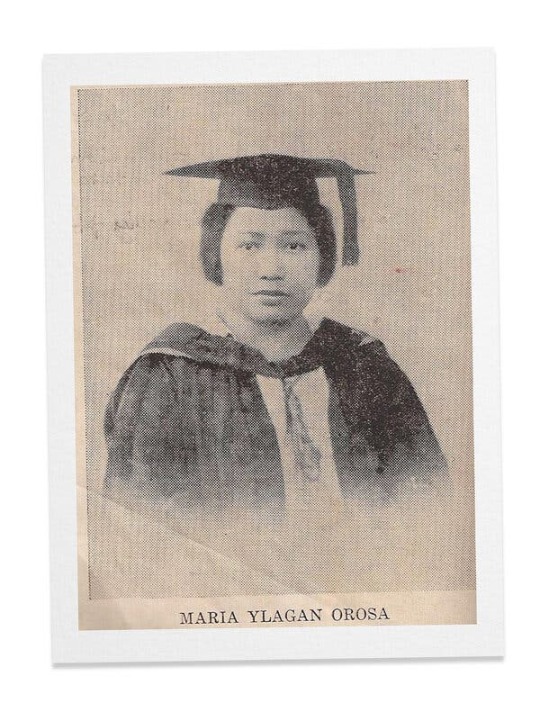
After completing her studies, Orosa was offered a job as an assistant chemist for the State of Washington but, as a committed nationalist, she chose to return to the Philippines to help her country become self-sufficient in food production through modern methods of preparation and preservation. She joined the government’s Bureau of Science and was soon leading its home economics and food preservation divisions.
Orosa was often called “an alchemist in the kitchen,” conjuring wines and jellies from native fruits, flour from bananas and cassava, and vinegar from coconuts. She developed local methods of canning fruit, notably frozen mangos, and invented the palayok oven, an earthenware pot widely used for cooking in rural areas without electricity.
“The practice of canning was virtually nonexistent in the Philippines,” the journalist Jessica Gingrich wrote in 2020 in the most authoritative account of Orosa’s life, published on the website Lady Science. “She nourished a nation through chemistry and culinary ingenuity.”
When Japan invaded and occupied the Philippines in 1941, Orosa joined a resistance movement called Marking’s Guerrillas, holding the rank of captain. She turned her attention to inventing nutrient-dense foods to sustain local fighters.

Her most notable inventions included soyalac, a drink made from soy beans, and darak, rice flour that could be eaten or baked into cookies rich in vitamin B-1, essential in preventing beriberi disease.
“One teaspoon a day” of darak “could keep a starving man’s digestive system open, his bowels functioning normally, no cramps,” Yay Panlilio, a guerrilla leader who was a friend of Orosa’s, wrote in a 1975 article in Women’s Journal. “A palm full could keep him on his feet. Two palms full, he could fight.”
She also organized a system for smuggling these lifesaving inventions to detainees in the Santo Tomas Internment Camp, where more than 4,000 civilians, most of them Americans, were held for four years.
During the final battle for Manila, Orosa was wounded in the foot by shrapnel and taken to Remedios Hospital, which overflowed with the wounded and with refugees from Japanese massacres.
The hospital came under American shelling, and Orosa was one of hundreds who died there, on Feb. 13, 1945. She was 51.
She kept people “from being starved to death,” her cousin Apolinario Orosa told the Filipino television network ABS-CBN in 2020. “And it was an American shell that killed her. That was the irony of it.”
Pedro Picornell, a volunteer at the hospital, wrote in a memoir that it was impossible to bury the bodies because the “Japanese shot at anybody who tried to move around in the streets.”
The dead were eventually buried in mass graves. Orosa’s remains were never identified.
Of her many legacies, banana ketchup remains the most beloved.
Claude Tayag, a Filipino chef, food writer and artist, said banana ketchup was “my savior” as a poor student when he doused it streetside on mashed sweet potato sandwiches or fried fish.
That it is made of bananas is “really not a big deal as far as we’re concerned,” he said in a telephone interview, “because it’s ours, it was invented here.”
He added: “Is there a law against making ketchup out of bananas? Does it have to be out of tomatoes?”
7 notes
·
View notes
Text
i learned that banana ketchup is made by a filipino war hero Maria Orosa, who invented 700 recipes, some of which were products of processing canned goods for guerilla warfare. These inventions saved thousands of Filipino and American people trapped in japanese world war II intern camps (x)


538 notes
·
View notes
Text
A food chemist and innovator, Maria saw that the Philippines was heavily reliant on imports like tomatoes. At the same time, she understood and envisioned the vast potential of a great many products endemic to the island nation that, when used properly, could make the country more self-sufficient. She was passionate about a self-sustaining Philippines and made it her life’s work to study native food, and the use of fermentation and various preserving techniques to educate and uplift people in need. She would eventually become a war heroine through her food innovations.
27 notes
·
View notes
Text
Spend the most wonderful time of the year at Waterfront Manila Pavilion Hotel
Date: November 27, 2017
Make your holidays a lot merrier this year with Waterfront Manila Pavilion Hotel and Casino!
Treat your family to a Southeast Asian expedition with A Dazzling Christmas, the delightful dinner buffet on Christmas Eve at Seasons restaurant, for only Php 950.00 per person. Bring your kids as well as they will surely enjoy the Christmas Kids' Corner, filled with fun activities and goody bag treats from our generous partners. Families and big groups will also have a fantastic Christmas with the Dine 5, Free 1 promo.
Suit up your most glittering outfit and welcome the sparkling 2018 with a bang! Join us for a night of dance, songs, drinks, and food with Sparkle On! The Manila Pavilion's New Year's Eve Buffet and Countdown for only Php 1,200 per person.
Relax, Party and Dine this Holiday!
Anticipating the Christmas break? Set your most-awaited holiday staycation anytime this December with the Relax, it's Christmas room promo. Pleasure yourself with a relaxing experience away from the Christmas rush and get a free consumable Php 1,000.00 voucher for all the Hotel F&B outlets.
Want to make it all-out this 2018? Why not avail the all-in New Year’s Eve Countdown Package and give joy to you and your loved ones in an overnight room accommodation, with New Year’s Eve Dinner Buffet and Sparkle On! New Year's Eve Countdown passes for three (3), breakfast buffet for two (2), and a 20% discount voucher for all F&B offers. Book a sparkling year-end for as low as Php 8,300.00.
So what are you waiting for? Start planning and make the holidays brighter with Waterfront Manila Pavilion Hotel and Casino!
###
For inquiries and reservations, visit the Manila Pavilion Hotel at United Nations Avenue corner Maria Orosa Street in Manila. Log on to www.waterfronthotels.com.ph or call 5261212 for inquiries and reservations; Follow @WaterfrontMNL for regular updates.
1 note
·
View note
Text
Sofia Reyes De Veyra

Sofía Reyes de Veyra (1876-1953)
Sofia Reyes de Veyra was born in and married the Resident Commissioner of the Philippines. In 1917, she accompanied him to Washington D.C. to advocate for Philipine independence from the United States. While she was there she and other Filipinas became active in the American suffrage movement.
Despite having only a few years of grammar school, Veyra was an extremely accomplished woman. She spoke three languages, had established the first nursing school in the Philippines, and founded several organizations serving the needs of women and malnourished infants. During her stay in America, she added to those accomplishments by joining the Congressional Red Cross unit, worked as her husband's personal secretary, raised their four children, knitted socks and sweaters for the army, and made it her personal mission to educate people about her home country by giving lectures using stereogram photos to proudly promote the Philippines and its people. She hosted a “made-in-the-Philippines” dinner at University of Missouri which featured Filipino students playing traditional music, food made by Filipino chefs and displayed the finest of Filipino handicrafts. She took correspondence courses in dressmaking, cooking, and housekeeping skills from the Women’s Institute of Domestic Arts and Sciences in Scranton, Pennsylvania. She was so popular that the Congressional Woman’s Club made an exception and allowed her to be their first non-resident member.
Upon her return to the Philippines, she became Dean of the Domestic Science Department of the Centro Escolar University and co-authored a cook book. She continued to be active in women’s clubs and promote women’s issues. She advocated for proper care for the mentally ill, unwed mothers, lepers, and other marginalized members of society. Filipino women were granted suffrage in 1937. The islands of Philippines were recognized as an independent nation in 1946
Another important Filipino woman studied chemistry at University of Washington (Seattle campus) in the 1920s. Maria Orosa went on to revolutionize the food industry in the Philippines and became a war hero in WWII. https://food52.com/blog/24700-maria-orosa-profile
Sources:
http://www.positivelyfilipino.com/magazine/the-thoroughly-modern-sofia-de-veyra
https://www.loc.gov/exhibitions/women-fight-for-the-vote/about-this-exhibition/more-to-the-movement/sofia-reyes-de-veyra/
#suffragettecity100#sofia reyes#sofia de veyra#sofia reyes de veyra#suffragist#suffragette#19th Amendment#philippines#filipina#filipino#filipino history#asian women history#asian leaders#women leaders#women's rights#women's history month#Maria Orosa#votes for women#suffrage
0 notes
Text
Ilang kalsada sa Maynila, isasara sa inagurasyon ni Marcos


Simula ngayong Linggo, Hunyo 26, isasara na ang ilang kalsada sa bisinidad ng National Museum sa Maynila bilang paghahanda sa inagurasyon ni President-elect Ferdinand Marcos Jr. sa Huwebes, Hunyo 30. Sinabi ng Metropolitan Manila Development Authority (MMDA), kabilang sa mga isasara ang Padre Burgos Avenue na nasa harapan ng National Museum, Finance Road, Maria Orosa Street mula TM Kalaw hanggang P. Burgos, at General Luna Street mula P. Burgos hanggang Muralla Street. Sa Hunyo 30, isasara na rin simula 4:00 ng madaling araw ang Ayala Boulevard at Victoria Street mula Taft Avenue patungong Muralla Street. Sarado rin sa trapiko ang Roxas Boulevard mula Buendia hanggang P. Burgos. Isasara rin sa Hunyo 29 hanggang gabi ng Hunyo 30 ang Mendiola Street na malapit sa Malacañang Palace. Kabilang din sa isasara ang Legarda Street sa kanto ng Mendiola, mula San Rafael hanggang Figueras Street, at Jalandoni Street sa may Philippine International Convention Center (PICC) sa Pasay City. Source: Manila Bulletin Read the full article
0 notes
Photo

Everything can be accomplished easier w/ unity esp. during these times. Last 2015 (prepandemic), we've blogged about Max's Group multibrand physical outlet - Burgos Eats. Now, Max's Group unites its multibrand even more thru its consolidated hotline: 888-79000 (for Metro Manila) & website: maxsgroupdelivers.com for all its brands: Yellow Cab, Max’s, Krispy Kreme, Pancake House, Teriyaki Boy, Dencio’s, Sizzlin’ Steak & Jamba Juice. So how about a feast like this to unite the whole family this season done w/in a single order? Presenting: @Yellowcabpizza 18" New York's Finest (1,155 php), @pancakehouseph Pan Chicken Nuggets & Fingers (803.85 php), !@krispykremeph Holiday Carnival (325 php) and Holiday Cinnamon Glaze (339 php) Doughnuts & @maxschicken Whole Fried Chicken (575 php). 多个品牌单次订货. #tsinoyfoodies #maxsgroupdelivers #maxsgroup #maxsrestaurant #krispykreme #friedchicken #yellowcab #yellowcabpizza #pizza #donuts #christmasfood #pancakehouse (at Max's Restaurant, Maria Orosa Ermita) https://www.instagram.com/p/CWhiSR4PsAa/?utm_medium=tumblr
#tsinoyfoodies#maxsgroupdelivers#maxsgroup#maxsrestaurant#krispykreme#friedchicken#yellowcab#yellowcabpizza#pizza#donuts#christmasfood#pancakehouse
1 note
·
View note
Photo

PAPA... have you eaten? 💛 #aznsauceoflove . Inventor Magdalo V. Francisco, Sr. - A humanitarian at heart, Maria had a vision of empowering the Filipino family. Credited with mass-producing banana ketchup in 1942, thus making it a fixture in the Filipino household. To this day it’s used as a condiment that accompanies many popular dishes such as tortang talong (an eggplant omelet), fried chicken, hamburgers, and Filipino spaghetti (pasta with banana ketchup and sliced hot dogs). ⠀⠀ A food chemist and innovator, Maria saw that the Philippines was heavily reliant on imports like tomatoes. At the same time, she understood and envisioned the vast potential of a great many products endemic to the island nation that, when used properly, could make the country more self-sufficient. She was passionate about a self-sustaining Philippines and made it her life’s work to study native food, and the use of fermentation and various preserving techniques to educate and uplift people in need. She would eventually become a war heroine through her food innovations. ⠀⠀ One day, she created a banana sauce with mashed bananas, vinegars, and spices. The brownish-yellow color was not very appetizing, so a little red dye was added, turning it to what is today known as banana ketchup. But her story is far vaster than her most popular invention. ⠀⠀ She launched Health, Heart, Head and Hand (4-H) Clubs. This organization brought herself and other educators into rural areas and barrios to teach women how to raise poultry and preserve food, as well as how to prepare and plan meals. By 1924, the organization had over 22,000 members. Part of her initiative was to introduce one of her inventions, the palayok oven—a clay oven intended for people who did not have access to electrical appliances. ��⠀ During World War II, Maria was a captain in Marking’s Guerrillas, a group of Filipinx soldiers who fought alongside the United States against the Japanese. Maria Orosa was a scientist, an activist, a humanitarian, and a war hero who loved her country and dedicated her life to uplifting the Philippines through food innovation. - via @food52 . #apahm #apaheritagemonth #bananaketchup #bloodygirlgang (at Daly City, California) https://www.instagram.com/p/CAS3ZRIBayy/?igshid=1umyhfi6blzuj
0 notes
Note
1, 14, 17 :)
sorry if this took a while to answer!! thanks for the ask!!
1. what’s your favorite place in your country?
i lowkey would like to say my university’s campus but the weather in manila sucks it really does but hmmmm despite the bad weather it’s nice to walk around so that’s my answer
14. do you enjoy your country’s cinema and/or TV?
movies yes!! we have local movie festivals like Cinemalaya and Metro Manila Movie Festival and i think it’s cool!! although most of the time im not up to date on whats happening (usually i only know ‘cause the people around me are up to date), like the last movie I watched from a local film festival was Bar Boys and that was more or less 2 years ago i think. the movie that really made me appreciate Filipino cinema was Heneral Luna (about General Antonio Luna and the Philippine American war)
TV shows not so much I don’t really keep up with any local shows oof although memes about like Ang Probinsyano are funny
17. are you interested in your country’s history?
YES, i think it’s super interesting and also important to study. like I had fun learning about Noli Me Tangere in high school and like my answer in the previous question about Heneral Luna it was a great movie that really focused on an underappreciated Filipino hero (believe it or not, his brother Juan Luna the painter is more famous) there are so many things people forget or tend to oversimplify but it’s important to revisit. Apolinario Mabini was exiled to Guam because he refused to pledge allegiance to the US, and theres tons of Filipino scientists like Maria Orosa who arent talked about much. usually the way philippine history is taught is kinda :/ like it’s framed as pre-colonial -> spanish colonization -> american colonization -> japanese occupation during WWII -> independence -> marcos dictatorship/martial law -> EDSA revolution -> present day and even then theres people who try to argue that marcos was a hero and martial law was necessary :(( but yeah it’s important to look at events, who is telling this from what perspective what is being omitted and usually philippine history glorifies heroes but overlooks ordinary people and acts like everything’s fine and colonization is over (i hope this answer made sense)
ask me questions from “hi im not from the US” ask set
0 notes
Text
Waterfront Manila Pavilion’s Chinese New Year Buffet: A Feast Fit for Emperors
Food aficionados and believers in the the power of food to usher in favorable fortune, will have luck on their side when Waterfront Manila Pavilion Hotel ushers in the Year of the the Dog. For the coming Chinese New Year, Chef Maurice Toh (Toh Khoon Meng) will offer treats from traditional Chinese cookery as well as recreations of wellloved dishes by Chef Lee Yan Feng of the hotel’s former Peony Garden Chinese restaurant.
At its height in 2005, the Peony Garden became the go-to restaurant for authentic Cantonese cuisine with a subtle Malaysian touch of flavor. As the restaurant’s culinary head, chef Feng designed the menu following the Cantonese cooking dictum of using only the freshest ingredients.
This year’s Chinese New Year Buffet brings back the rich flavors of Peony Garden. It includes heartwarming Egg and Rice Noodle Soups (filled with prawns, lapu-lapu slices, fish balls, fish cake, a variety of mushrooms, fresh vegetables, tofu, and so much more), the creamy Double Boiled Pumpkin Seafood Soup, and the spicy Hot and Sour Szechuan Soup.
Dimsum lovers can have their fill of flavorful siomai, ha kaw, chicken feet, and asado siopao. The salad bar, too, offers an array of healthy but scrumptious choices such as Fried Garlic and Dry Seafood Cucumber Salad, Hot Bean Chicken Salad, Fried Tofu Salad, Century Eggs with Ginger and Mixed Green Salad.
The main course lists tasty and filling entrees as Steamed Barramundi with Jiang Zheng Sauce, Deep-fried Boneless Chicken with Sweet and Spicy Chili, Stir-fried Clams with Ginger & Chilli Onion Sauce, Garlic Salt & Pepper Pork Rib, Deep-fried Pork Rib with Honey Sauce, and Stir-fry Green Bean with XO Sauce.
Mini appetizers include such exotic creations as Black Fungus Salad in Asian Dressing, Crispy Prawns Spring Rolls with Mango Sauce, and Deep-fried Prawns with Mixed Fruit Salad and Corn Flakes. The carving station features succulent choices like Cantonese Char Siu Pork Belly, Lechon Pork Belly Roll, Soy Chicken, and Roast Duck.
Of course, those with a sweet tooth will find delight in the buffet’s dessert selection -- Chinese Pineapple Cookies, Tikoy (Nian Gao), Leeches Almond Jelly, Longan with Grass Jelly, Mango Pudding with Pomelo Sago and Coconut Milk, Green Tea Cream Brulee with Gula Melaka, Rock Melon Sago, Assorted Fruits Jelly, Assorted Chinese Cookies, Assorted Filipino Dessert, and Egg Tarts.
Waterfront Manila Pavilion’s Chinese New Year Buffet is available from February 16 at Php 1,200 per persons, and only Php 600 for children aged 6 to 11 years old. In addition, groups exceeding 6 or more persons can enjoy the “6+1 Promo” where 1 of the group gets to enjoy the Chinese New Year Buffet for free. Reserve a seat now and call Seasons restaurant at (02) 526-1212 loc. 2318.
Now on its 50th year, Waterfront Manila Pavilion continues to create extraordinary experiences of comfort, convenience and luxury as it brings back the pleasurable amenities and offerings from the past.
###
For inquiries and reservations, visit the Waterfront Manila Pavilion Hotel at United Nations Avenue corner Maria Orosa Street in Manila. Log on to www.waterfronthotels.com.ph or call 5261212 for inquiries and reservations; Follow @WaterfrontMNL for regular updates.
#CNY#Chinese#lunar new year#Chinese New Year#Year of the Dog#2018#hotel#buffet#waterfronthotels#press release#media
0 notes
Text
My French learner and I have talked about the influence of French cuisine on modern day cooking. He said most of the top international chefs are French and I believe it's true!
With admiration on his passion for cooking and his heritage, I began to think about my own country's food history. Because the Philippines was conquered by three countries in many centuries, I guess it's hard to identify what's originally Filipino. So to explain about authentic Filipino food has been somewhat challenging.
But when I stumbled upon this article while researching more on this, I couldn't help smiling when I learned that a Filipina food chemist and innovator shaped the food culture in my country and saved many lives during World War II.
Read on to get inspired by Maria Orosa. :)
0 notes